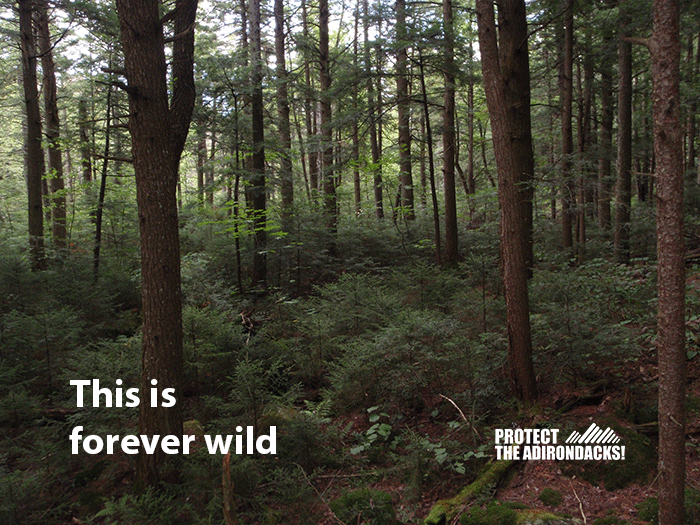Protect the Adirondacks is a private membership-supported organization dedicated to stewardship and open space protection in the Adirondack Park for current and future generations. Protect the Adirondacks pursues this mission through grassroots organizing, advocacy, education, research, independent public oversight of state and local agencies, and legal action. Protect the Adirondacks is led by a volunteer Board of Directors and professional staff and maintains a headquarters in Johnsburg, New York, in the central Adirondacks.
The Adirondack Park is an unusual park. Millions of acres of constitutionally protected Forest Preserve surround and are surrounded by further millions of acres of privately owned land. It is home to loons, moose, and bears, and it is also home to 130,000 New Yorkers living in towns and villages throughout the Park. Adirondack residents live in and enjoy one of the world’s great experiments of people and wilderness existing side by side. The Adirondack Park is a checkerboard of public and private lands and includes 92 towns and spans across 12 counties. At a size of nearly six million acres, the Park is bigger than all national parks and several states.
Protect the Adirondacks has been a leading voice defending the Forest Preserve and protecting the environment of the Adirondack Park for more than a century. Protect the Adirondacks was formed in 2009 in a merger of the Association for the Protection of the Adirondacks, established in 1902, and the Residents’ Committee to Protect the Adirondacks, established in 1991. Protect the Adirondacks continues a long tradition of defending the public “forever wild” Forest Preserve, protecting wildlife, waters, the great forests, and rural communities of the six-million-acre Adirondack Park.
2023 marked the 26th year of the Adirondack Lake Assessment Program (ALAP), which has grown to one of the best long-term citizen science programs in the U.S. Protect the Adirondacks manages ALAP in partnership with the Adirondack Watershed Institute at Paul Smith’s College. Trained volunteers who participate in ALAP take a series of water samples monthly through the summer season and a report is published each year. ALAP has documented high levels of road salt pollution in a number of leading lakes across the Adirondacks, among other key water quality challenges.
Protect the Adirondacks manages a wide variety of education, advocacy, and long-term research projects. Protect the Adirondacks partners with the Kelly Adirondack Center of Union College in the preservation and management of the Adirondack Research Library, a collection of historic materials about Adirondack conservation and cultural history. The Adirondack Research Library is open to the public and is located in Niskayuna, New York.
The public Forest Preserve shapes the Adirondack Park experience by providing stunning outdoor recreational opportunities and underwriting the local tourism economy. It also safeguards a vast array of natural habitats that protect ecological integrity and complexity across a broad, intact landscape. The Forest Preserve was created in 1885, made forever wild in 1894 in the New York Constitution, and has grown to over 2.6 million acres over the last 133 years through a bipartisan, multi-generational commitment of New Yorkers. A core focus of the work of Protect the Adirondacks is research and advocacy to protect the Forest Preserve. Each year, work is undertaken to advocate for state funding for land acquisition and for state stewardship of trails and facilities. Protect the Adirondacks works on the classification of Forest Preserve lands, with a special focus on expanding designated Wilderness areas. Each year, we monitor state land classification and Unit Management Plans for different Forest Preserve areas, and undertake fieldwork to identify areas of overuse or where management can be improved.
In addition to the defense of the Forest Preserve, Protect the Adirondacks conducts independent public oversight of state agencies that manage public and private lands in the Adirondacks, such as the Adirondack Park Agency and Department of Environmental Conservation, among others, to ensure that environmental laws, regulations, and policies are upheld and decisions are made in open, transparent, and accountable forums. Protect the Adirondacks is committed to strengthening New York’s environmental laws for public and private land regulation and protection in the Adirondacks.
Protect the Adirondacks also works to protect water quality by strengthening environmental laws and programs to meet the threats of road salt pollution, aquatic invasive species infestation, and stormwater pollution from shoreline and watershed development. We work to protect wildlife, to try to meet the immense challenges facing the Adirondacks from climate change, and help with community development projects in the small rural communities of the Adirondacks.
Protect the Adirondacks publishes three newsletters and an annual report each year as well as e-bulletins, action alerts, and special reports. The Board of Directors consists of volunteers with a great breadth of experience in Adirondack Park history, environmental law, small business, local government, state environmental agency management, financial management, and state government. The Board manages a series of committees, including the Conservation & Advocacy Committee, which is the nerve center of the organization.
Through all of this work and different programs, Protect the Adirondacks has racked up a long list of impressive successes that have helped to protect the environment and rural communities of the Adirondack Park.
Protect the Adirondacks owns and maintains an energy efficient headquarters in Johnsburg that is powered by a solar array and windmill. The headquarters houses staff offices.
We encourage you to join with us as a member today! Click here to sign up.
Protect the Adirondacks has earned a “Gold” level rating by Guidestar, which details levels of organizational transparency of non-profits.


